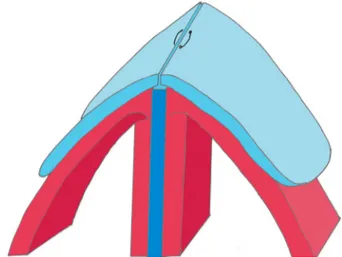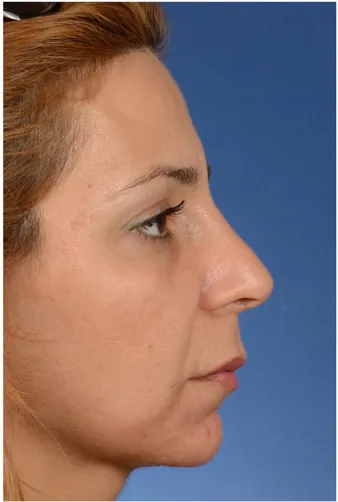www.bjorl.org
Brazilian
Journal
of
OTORHINOLARYNGOLOGY
ORIGINAL
ARTICLE
Evaluation
of
postoperative
patient
satisfaction
after
covering
the
nasal
dorsum
with
upper
lateral
cartilage:
‘‘upper
lateral
closing’’
夽
Can
Alper
C
¸a˘
gıcı
BaskentUniversityAdanaSeyhanHospital,ENTDepartment,Seyhan,Turkey Received11March2017;accepted24October2017
Availableonline16November2017
KEYWORDS Rhinoplasty; Lateralnasal cartilage; Nasaldorsum; Middlevault; Covering Abstract
Introduction:Followingnasalhumpremovalduringseptorhinoplasty,themiddlevaultshouldbe reconstructedtoavoidfunctionalandestheticproblems.Middlevaultreconstruction,however, mayresultinwideningofthemiddlevaultandmayneedacamouflagegrafttocoverdorsal irregularities.
Objective: Topresenttheresultsofreconstructingthemiddlevaultwithatechniquethatcovers thenasaldorsumwithupperlateralcartilage,fromtheviewpointofpatientsatisfaction.
Methods:Retrospectivestudyofpatientswhounderwentseptorhinoplastythatincludednasal dorsumclosurewithupperlateralcartilagefromDecember1,2014toJanuary31,2016.Those with postoperative follow-up ofless than3 months were excluded. The final study group included 39 patients. The same surgeon performed all septorhinoplasties. The dorsum was closedusingan‘‘upperlateralclosing’’techniquethatapproximatedupperlateralcartilages toeachotherovertheseptum.Postoperativepatientsatisfactionwasdeterminedusingavisual analogscaleandtherhinoplastyoutcomesevaluationquestionnaire.Thequestionnaire evalu-atespatientestheticandfunctionalsatisfactionwiththeoperatednose.Highscoresindicate improvedestheticresults.
Results:No dorsal irregularities were seen at postoperative follow-up evaluation of the patients. For esthetic nasalappearance, themedian visual analogue scalescores was 86%, andthemeanforthequestionnairewas77.03%.
夽 Pleasecitethisarticleas:C¸a˘gıcıCA.Evaluationofpostoperativepatientsatisfactionaftercoveringthenasaldorsumwithupperlateral
cartilage:‘‘upperlateralclosing’’.BrazJOtorhinolaryngol.2019;85:71---7.
E-mail:ccagici@hotmail.com
PeerReviewundertheresponsibilityofAssociac¸ãoBrasileiradeOtorrinolaringologiaeCirurgiaCérvico-Facial. https://doi.org/10.1016/j.bjorl.2017.10.011
1808-8694/©2017Associac¸˜aoBrasileiradeOtorrinolaringologiaeCirurgiaC´ervico-Facial.PublishedbyElsevierEditoraLtda.Thisisanopen accessarticleundertheCCBYlicense(http://creativecommons.org/licenses/by/4.0/).
Conclusion:Thenaturaldome-shapedanatomyofthenasaldorsumwasachievedby approxi-matingtheupperlateralcartilagestoeachother.Closingthedorsumwiththistechniquealso coversanydorsalirregularitiesandresultsinasmoothdorsum.Patientsexpressedsatisfaction withtheestheticandfunctionalaspectsofthesmooth,attractivenasaldorsum.
© 2017 Associac¸˜ao Brasileira de Otorrinolaringologia e Cirurgia C´ervico-Facial. Published by Elsevier Editora Ltda. This is an open access article under the CC BY license (http:// creativecommons.org/licenses/by/4.0/). PALAVRAS-CHAVE Rinoplastia; Cartilagemnasal lateral; Dorsonasal; Abóbadamédia; Cobertura
Avaliac¸ãodasatisfac¸ãopós-operatóriadopacienteapóscoberturadodorsonasalcom acartilagemlateralsuperior:‘‘fechamentolateralsuperior’’
Resumo
Introduc¸ão:Após aremoc¸ãoda gibanasal durantearinosseptoplastia,a abóbadadeve ser reconstruídaparaevitarproblemasfuncionaiseestéticos.Areconstruc¸ãodaabóboda entre-tanto,poderesultarem alargamentodorsalepodenecessitardeumenxertoparacamuflar irregularidadesdorsais.
Objetivo:Avaliarasatisfac¸ãodospacientescomosresultadosdareconstruc¸ãodaabóbodacom umatécnicaqueutilizaacartilagemlateralsuperiorpararecobrirodorsonasal.
Método: Estudo retrospectivo de pacientes submetidos a rinosseptoplastia, que incluiu fechamentododorsonasalcomcartilagemlateralsuperior,realizado de1◦ dedezembrode 2014a31dejaneirode2016.Foramexcluídosaquelescomacompanhamentopós-operatório demenosde3meses.Ogrupofinaldoestudoincluiu39pacientes.Omesmocirurgiãorealizou todasasrinosseptoplastias.Odorsofoifechadocomumatécnicade‘‘fechamentolateral supe-rior’’queaproximaascartilagenslateraissuperioresdecadaladosobreosepto.Asatisfac¸ão pós-operatória dos pacientes foi determinada através de uma escala visual analógica e o questionárioRhinoplastyOutcomes Evaluation.Oquestionárioavaliaasatisfac¸ãoestéticae funcionaldopacientecomonariz.Escoresaltosindicampercepc¸ãodemelhoriaestética.
Resultados: Nãoforamobservadasirregularidadesdorsaisnaavaliac¸ãopós-operatóriade segui-mentodospacientes.Emrelac¸ãoàaparêncianasalestética,oescoremédiodaescalavisual analógicafoi86%eoescoremédiodoquestionáriofoi77,03%.
Conclusões:Aanatomianaturalemformadedomododorsonasalfoiconseguidaatravésda aproximac¸ãodascartilagenslateraissuperioresentresi.Ofechamentododorsocomessa téc-nicatambémabrangetodasasirregularidadesdorsaiseresultaemumdorsoliso.Ospacientes expressaramsatisfac¸ãocomosaspectosestéticosefuncionaisdodorsonasallisoeatraente. © 2017 Associac¸˜ao Brasileira de Otorrinolaringologia e Cirurgia C´ervico-Facial. Publicado por Elsevier Editora Ltda. Este ´e um artigo Open Access sob uma licenc¸a CC BY (http:// creativecommons.org/licenses/by/4.0/).
Introduction
Nasalhumpremovalisoneofthemostcommonprocedures duringseptorhinoplasty.Followinghumpremoval,the mid-dle vault should be reconstructed, especially in patients withalargehump.Ifthisstepisnotcompleted,theupper lateralcartilagesmigrateinferolaterally,possiblyresulting in functional and esthetic problems.1 Various techniques
havebeen usedtoaddressthisproblemduring reconstruc-tionofthemiddlevault,includingprimaryclosureorclosing thedefectwithaspreadergraftorspreaderflap.
Thespreadergraft,oneofthemostpopulartechniques forclosingthemiddlevault,involvesplacingarectangular pieceofcartilagebetweentheupperlateralcartilageand theseptum.1---4 Itspans the point at which theupper
lat-eralcartilages andseptum meet. It is quite effective for correcting high septal deviations. This method, however, requires additionalcartilage4,5 becausethere may notbe
anadequatecartilageintheseptum,especiallyinrevision cases.4 Also,it istechnically difficultwhenusinga closed
approach.2,4,5Inaddition,itwidensthemiddlevault,6,7and
sowouldnotbepreferredinpatientswithawidedorsum. Thespreaderflap,themostwidelyacceptedmiddlevault reconstructiontechnique,entailssuturingthemedialendof theupperlateraltotheseptumbyfoldingitinonitself.2,8---11
The most important advantage of thisflap is thatis does not requireadditionalcartilage tissue.The medialend of theupperlateralcartilage,whichispreservedduringhump removal,isusuallyenoughcartilageforthistechnique.The middle vault, however, does not reachthe desired width using a spreader graft. To overcome this drawback, vari-oussuturetechniquesweredevelopedforcreatingspreader flaps.2,5,10,12,13
The middle vault is the middle portion of the dorsal esthetic line, which is oneof the most important param-etersforanestheticallyattractivenose.Themiddlevaultis
composedofthefusedupperlateralcartilageandseptum.3
AlthoughitisaT-shapedstructureatthepointofunion,the middlevault isdome-shapedinthecoronalplane,9,14
sup-ported inferiorly by the septum.9 A dome-shaped dorsum
maynotbeachievedprecisely byeitherthespreaderflap orgraft.Whenusingaspreaderflap,threecartilages---two upperlateralcartilageflapsandtheseptum---arebrought sideby side.This unionresultsin anunnatural plateauof thenasaldorsum.Thisappearanceismorepronouncedwhen usingaspreadergraftbecauseinspreadergraftsfive differ-entcartilagesegments--- twoupperlateralcartilages,two spreadergrafts,andtheseptum--- arebroughtsidebyside. Analternativetechniqueisthusneededtoobtaina nat-uralappearanceof thedome-shaped nasaldorsum,which couldbeobtainedbyareconstructivetechniquethatwould restorethedorsumtoitsnaturalanatomicalconfiguration. One method, which we have now used for 3 years, is to approximatetheupperlateral cartilagestoeach otherby suturingthemovertheseptum.Thistechniquerestoresthe naturaldome-shapedanatomyofthedorsumwithout widen-ing it. Patient satisfaction has been high when the ideal natural dorsal profile is achieved, as it is with this tech-nique,whichiswhyweevaluatedourpostoperativeresults inregardtothepatients’satisfaction.Theaimofthisstudy wastopresent our algorithmfor closing themiddle vault withupperlateralcartilageandreviewourresultsbasedon patientsatisfaction.
Methods
We retrospectively evaluated the medical records of patients who underwent septorhinoplasty during which upper lateral cartilage was used for dorsal closure after removing the nasal hump. The same surgeon, who had used this technique since December 1, 2014, performed allseptorhinoplasties.Weincludedallpatientswho under-wentnasalhumpremoval(forestheticreasonsinallcases) andclosing of themiddle vault. Previousnasal surgeryor traumawasnotan exclusioncriterion.Weroutinely asked thepatientstoreturnforevaluationat3and6monthsand 1 yearpostoperatively, at whichtime theywereasked to completesatisfactionforms.
Duringthe follow-upvisits, the patientswere askedto marktheVisualAnalogScale(VAS)forthecosmetic appear-ance(answersrangingfrom‘‘completelyunhappy’’to‘‘very happy’’)andtofillintheRhinoplastyOutcomesEvaluation (ROE)15questionnaire.ROEevaluatespatients’estheticand
functionalsatisfactionaboutthenosewithsixquestions.All questionsarescoredfrom0to4.Thetotalscoresmaythus be0---24.Theserawscoresaredividedby24andmultiplied by100.Assessmentsarethusexpressedaspercentages.High scoresmeanimprovedestheticresults.
We retrospectively evaluated the patient’s files. We included all patients whofilled in the forms at the post-operative follow-up visits. Were-invited patients whodid notcomeforafollow-upvisit.
ThisstudywasapprovedbytheBaskentUniversity Insti-tutional ReviewBoard(Projectn◦ KA16/78).We obtained approvalfromthepatientstopublishtheirphotographs.
Figure 1 Schema for approximation of the upper lateral
cartilages (light blue) over the septum (dark blue). The mucopericondriumisshowninred.
Surgicaltechnique
Wepreoperativelyevaluatedallpatientsfornasal obstruc-tion.In patientswith hypertrophy of theinferior concha, weappliedradiofrequencytotheinferiorconchaand later-alizedit.Weendoscopicallyexcisedthelaterallamellaof themiddleconchabullosaifitwaslargeenoughtoobstruct thenasalpassage.Wecorrectedtheseptumdeviationwith septoplasty.Wealwaysleftanintactandstrong‘‘Lstrut.’’ Weusedanopenorclosedapproachforrhinoplasties.An inverted-Vtranscolumellar incisionwasmadeduring open rhinoplasty. Transfixation, infra-cartilaginous, and inter-cartilaginousincisionswereusedfortheclosedapproach.
The following steps were the same for both open and closed approaches. We elevated the dorsum in the supra-perichondrial and sub-periosteal plane. We bilater-allyelevatedthemucoperichondriumandmucoperiosteum ofthe nasalseptum. We separatedtheupper lateral car-tilage from the septum by scissors, elevated 1---2mm of mucoperichondriumunderthemedialendoftheupper lat-eralcartilages,andexcised thecartilage hump withan # 15blade. Wedid notexcise anycartilage fromtheupper lateralcartilage atthatpoint.We thenremovedthebony humpandnarrowedthenasalroofvialateralandtransverse osteotomies.Thecephalicportionofthelowerlateral carti-lagewasthenresectedandacolumellarstrutorhemidomal and/or interdomal tip sutures were placed according to need.
Coveringthedorsumwithupperlateralcartilage
Hereafter,thetechniqueofcoveringthedorsumwithupper lateralcartilageiscalled‘‘upperlateralclosing.’’For mid-dlevaultreconstruction,weapproximatedtheupperlateral cartilageovertheseptumwithtwoorthree3/0polyglactin 910sutures(Fig.1).Wedidnotpassthesuturesthroughthe septumduringthisapproximation.Thedome-shapednormal anatomyofthedorsumwasnowestablished.Wealsotried toensurethattheapproximationoftheupperlateral car-tilageswasnottoolooseortoostretched. Weexcisedthe excesspartsoftheupperlateralcartilagewhenitwasloose.
Figure2 Correcteddorsalestheticlinewithnormalmiddlevaultwidenessisseenpreoperative(left)andpostoperative(right) frontalviews.HerVisualAnalogScale(VAS)scoreforestheticappearanceofthenosewas86%,andherROEscorewas83%.
Figure3 Iatrogenic cartilaginoushumpasaresultof inad-equate adjustment of the septal height. Her VAS score for estheticappearanceofthenosewas 86%,andherROEscore was58%.
Thedorsalheightafterapproximatingtheupperlateral car-tilagesover theseptumshouldbeevaluatedtopreventan iatrogenichump.Weusuallyremovedapproximately1mm moreofthecartilaginousnasalhumpthanwasrequired.
Patientswithlargehump
Forlargehumps,weperformedbilateralparamedianwedge resectionsofthenasalbone.Thisactionhelpedus approxi-mationofthewidelyseparatedupperlateralcartilageswith eachother.
Patientswithhighseptumdeviation
Wecorrectedhighseptaldeviationusingaseptal enhance-mentgraft placedmoreinferiorlythantheusualspreader graft.Wethenproceededwiththe‘‘upperlateralclosing’’ overthecorrectedseptum.
Statisticalanalysis
Statistical analysis was performed using the statisti-cal package SPSS (Version 17.0; SPSS Inc., Chicago, IL, USA). If continuous variables were normal, they were described as themean±standard deviation(p>0.05 with the Kolmogorov---Smirnov test or the Shapira---Wilk test;
n<30). Ifthecontinuous variables werenot normal,they wererecordedasthemedian.
Results
Wehavebeenusingtheupperlateralclosingtechniquesince December1,2014andhaveapplieditin121patients(until April30,2016).Uptothatdate,31patientshadnotreached
Figure4 Partiallycorrectedhighdorsaldeviation.Preoperative(left)andpostoperative(right)frontalviewofthepatientare shown.HerVASscoreforestheticappearanceofthenosewas77%,andherROEscorewas63%.
their postoperative 3rd month and so were not included in study.In all, 90 patients completed 3rd postoperative month,but51ofthemdidnotcometoanyofthescheduled postoperative follow-up sessions (longer than 3 months). Noneofthesepatientswereincludedinstudy.Ifthepatient cametomorethanoneoftheproposedfollow-upvisits,the resultsofthelatestvisitwereused.Only39patientswere finallyincludedinthestudy.
The upper lateral closing technique was used in all patients (mean±SD: age 27.84±8.77 years; 29 women; follow-up7.76±3.99months).Openapproachwasusedin 36 patients (92.3%). We usedseptal enhancement grafts, whichwereplacedmoreinferiorlythantheusualspreader grafts,tocorrectthehighseptaldeviationinninepatients (23%).Wedidnotusethespreadergraftsinanypatient.
Theresultsofeachpatient’stestsatthelatestfollow-up visitwerecollected,andthemeanROEandthemedianVAS scoresforestheticappearancewerecalculated.Themedian VAS score for esthetic appearances of the nose was 86% (scale0---100%).ThemeanROEscorewas77.03%±17.01%.
We obtained a dome-shaped smooth dorsum in all patients(Fig.2).Wedetectednoirregularitiesonthe carti-lagedorsum.Therewerefewcomplications.Fourpatients had residual bonyhump due toinadequate removal.Two patients had an iatrogenic cartilaginous hump becauseof inadequateadjustmentoftheseptalheight(Fig.3).These patients underwentrevisionsurgery. Another revisionwas madeinapatientbecauseofuncorrectedhighdorsal devia-tioncaudally(Fig.4).OnepatienthadaninvertedV defor-mitybecauseofoverly-resectedupperlateralcartilage.
Discussion
Nasalhumpremovalisoneofthemostcommonlyusedsteps in septorhinoplasty. After its removal, the upper lateral
cartilagesaredetachedfromtheseptum,causingtheupper lateralcartilagestorecoilposteroinferiorly.7Thissituation
results in disturbance of the dorsal esthetic line, which if not reconstructed can result in middle vault collapse and an inverted V deformity.16 Spreader grafts and flaps
are the most widely used techniques for reconstructing themiddlevault.1---4,8---10However,they(especiallyspreader
grafts)provideaplateauappearancetothedorsum,which changes the dorsum so it no longer has itsnatural dome shape,andthe brow-tipestheticline becomesmore arti-ficial. Spreader grafts require additional cartilage tissue, whereasspreaderflapsdonot.4,5 Occasionally,camouflage
graftsmaybeneededtocoverdorsal irregularities.3,4 The
‘‘upperlateralclosing’’techniquedoesnotwidenthe mid-dlevault,doesnotrequireadditionalcartilagetissue,and doesmaintainthedome-shapednaturalanatomyofthe dor-sum. ‘‘Upper lateral closing’’ provides good estheticand functionalresults,whichinthisstudyweresupportedbythe ROEandVASscores.Therewasnoneedforcamouflagegrafts tohidedorsalirregularitiesbecausetheywerecoveredby upperlateralcartilage.
Patient satisfaction with the results of our rhinoplas-tieswashigh.ThepostoperativemeanROEwas77.03%and themedianVASscorefor estheticappearanceof thenose was86%. A dome-shaped appearance of the middle vault was achieved in all patients. Palpation revealed no dor-salirregularitiesinanyofpatients.Complicationsincluded aninverted Vdeformityinoneof thepatientsbecauseof overly-resectedupperlateralcartilage.Twopatientshadan iatrogeniccartilaginoushumpbecauseofinadequate adjust-mentofseptalheight.Fourpatientshadaslightbonyhump becauseof inadequateremovaloftheoriginal hump.One patientreturnedwithanuncorrectedC-shapedhighseptal deviationthatwasdue toinadequatecorrectionof ahigh septaldeviationcaudally.
To date, the most preferred technique for high septal deviationhasbeenthespreadergraft.Weusedan enhance-mentgraft,however,whichwasplacedmoreinferiorlythan thespreadergraftbutparalleltoitinninepatients.First,we adjustedtheseptalheight.Then,wecorrectedthehigh sep-taldeviation(ifpresent)usingaseptalenhancementgraft. Later,we closedthedorsumwiththe‘‘upperlateral clos-ing’’technique.Previously, Sciutoand Bernardeschi17 had
positionedthespreadergraftsmoreinferiorlytodecrease widening of the middle vault, and they closed the sep-tumbyapproximatingtheupperlateralcartilagesoverthe spreadersinamannersimilartoours.Oneofourpatients returnedwithanuncorrectedC-shapedhighseptaldeviation forwhichwehadpreviouslyusedaseptalenhancementgraft (Fig.4).Theprobleminthispatientwasthelackofseptal enhancementneartheanteriorseptalangle.Wecorrected thedeviationusingaseptalextensionthatwasplacedmore caudallyduringtherevisionsurgery.
Afternasalhumpremovalinpatientswithalargehump, the upper lateral cartilages, similar to nasal bones, stay apart from each other. It is not easy to reapproximate them. Roostaeian et al.7 had advised ‘‘tension spanning
suture,’’whichadvancestheupperlateralsbeyondthe sep-tum,withthecartilagereturningtoitsoriginalpositionin patientwithbig humps.Theyadvised primary reconstruc-tionof the middle vault without using ‘‘tension spanning suture’’ifthepatienthasaminimalhumpwithstrong carti-lage.Althoughtheyadvisedprimaryclosureonlyinpatients withasmallhump,wesuccessfullyclosedthedorsumwith ‘‘upperlateral closing’’ in patients witha large hump as well.Inthosepatients,weundertookaparamedianwedge resectionfromthenasalbone, whichhelpstheextremely separated upper lateral come together. These two tech-niques,‘‘tensionspanningsuture’’plusparamedianwedge resectionmay be combined in patient with large humps, althoughweareveryhappyabouttheresultsachievedusing ourtechnique.
Someirregularitiesonthedorsumareseen afterhump removalor dorsum reconstruction.3,6,7 There may alsobe
someirregularitiesduringthehealingperiodevenona suc-cessfullyreconstructeddorsum.Camouflagegraftsandflaps areusedtocover theseirregularities.3,4 Withthe‘‘upper
lateralclosing’’technique,theupperlateralcartilage cov-erstheseirregularities,sothereisnoneedforcamouflage grafts.Todate, however,palpationhas revealedno carti-lageirregularitiesinthesepatients. Hence,in additionto restoringtheoriginalanatomywithhighestheticoutcomes, supportedbyhighVASandROEscores,‘‘upperlateral clos-ing’’providessmoothdorsum.
‘‘Upperlateralclosing’’alsoaddssomeheighttothe sep-tumbecauseupperlateralcartilagesareapproximatedover theseptum.Thisshouldbetakenintoconsiderationwhen adjustingthedorsalheight.Ifnot,inadequateadjustment mayresultinaniatrogenicnasalhump(Fig.3).Wesawthis complicationintwoofourpatientsandcorrecteditduring revisionsurgery.
Coveringthedorsumwithupperlateralcartilageisnot anewtechnique.SciutoandBernardeschi17 haddescribed
‘‘upperlateralcartilagesuspension’’toovercomeinternal valvecompromise.Intheirtechnique,theupperlateral car-tilageissuspendedoveradorsalspreadergraft.Thismethod is a combination of a spreader graft and ‘‘upper lateral
closing’’.Theyadvisedthatthistechniquebeappliedonly inpatientswithinternalnasalvalvecollapse.Faymanand Potgieter18 had also brought the upper lateral cartilages
togetherina‘‘vest-over’’fashiontoovercomedorsal irreg-ularitiesandmiddlevaultnarrowing,butitisnotend-to-end approximation.DayanandGreene19hadusedasimilar
clos-ing technique that was similar to ours. They used this techniqueonlyinpatientswiththinskintoobtainasmooth, naturalnasaldorsum.Roostaeianetal.7hadadvisednearly
thesameclosingtechniqueforthemiddlevaultinpatients withsmallhumpsandstrongcartilage.Wehavebeen suc-cessfullyusingthis‘‘upperlateralclosing’’techniqueinour patientsregardlessofskinthicknessandhumpsize.
Themostimportantdrawbackofthestudyisthatitwas retrospective, soitwasnotpossibletouserandomization toovercomeselectionbias.However,wedidnotselectany patients,includingthosewhocompletedthe3-month post-operative follow-up evaluation. Another limitation is that we do not yet know the long-term results of this tech-nique.Weareexpectingthatthelong-termfunctionaland esthetic results of the study will begood because of the favorableshort-termresults.Itwouldbeinterestingto com-parethistechniquedirectlywithotheravailabletechniques inaprospectivestudy.
Conclusion
The‘‘upperlateralclosing’’technique,whichreconstructs the natural dome-shaped anatomy of the dorsum, also achievesasmoothdorsum.Itisaneasy,reproducible tech-nique for closing the middle vault. For more definitive conclusions,wemustawaitthelong-termresults.
Funding
Thisresearchdidnotreceiveanyspecificgrantfromfunding agenciesinthepublic,commercial,ornot-for-profitsectors.
Conflicts
of
interest
Theauthordeclaresnoconflictsofinterest.
Acknowledgments
WethankC¸a˘glaSarıtürkforthestatisticalanalysis.
References
1.SheenJH.Spreadergraft:amethodofreconstructingtheroof ofthemiddlenasalvaultfollowingrhinoplasty.PlastReconstr Surg.1984;73:230---9.
2.Gruber RP, Park E, Newman J, Berkowitz L, Oneal R. The spreader flap in primary rhinoplasty. Plast Reconstr Surg. 2007;119:1903---10.
3.McKinneyP,JohnsonP,WallochJ.Anatomyofthenasalhump. PlastReconstrSurg.1986;77:404---5.
4.JangYJ,SinhaV.Spreadergraftinsepto-rhinoplasty.IndianJ OtolaryngolHeadNeckSurg.2007;59:100---2.
5.Manavbas¸ıYI,Bas¸aranI.Theroleofupperlateralcartilagein dorsalreconstructionafterhumpexcision:section1.Spreader flapmodificationwithasymmetricmattresssutureand exten-sionofthespreadingeffectbycartilagegraft.AestheticPlast Surg.2011;35:487---93.
6.GeisslerPJ,RoostaeianJ,LeeMR,UngerJJ,RohrichRJ.Role ofupperlateralcartilagetensionspanningsutureinrestoring thedorsal aestheticlinesinrhinoplasty. PlastReconstrSurg. 2014;133:7e---11e.
7.Roostaeian J, Unger JG, Lee MR, Geissler P, Rohrich RJ. Reconstitutionofthenasaldorsumfollowingcomponent dor-sal reduction in primary rhinoplasty. Plast Reconstr Surg. 2014;133:509---18.
8.OnealRM,BerkowitzRL.Upperlateralcartilagespreaderflaps inrhinoplasty.AesthetSurgJ.1998;18:370---1.
9.BerkowitzRL, Gruber RP.Management ofthe nasal dorsum: constructionandmaintenanceofabarrelvault.ClinPlastSurg. 2016;43:59---72.
10.KovacevicM,WurmJ.Spreaderflapsformiddlevaultcontour andstabilization.FacialPlastSurgClinNAm.2015;23:1---9. 11.OzmenS,AyhanS,FindikciogluK,KandalS,AtabayK.Upper
lateral cartilage fold-in flap: a combined spreader and/or splay graft effect without cartilage grafts. Ann Plast Surg. 2008;61:527---32.
12.ErenSB,TugrulS,OzucerB,MericA,OzturanO.Autospreading springflap techniquefor reconstructionofthemiddlevault. AestheticPlastSurg.2014;38:322---8.
13.GörgülüT,ÖzerCM,KargiE.Theaccordionsuturetechnique: amodifiedrhinoplastyspreaderflap.JCraniomaxillofacSurg. 2015;43:796---802.
14.Manavbas¸iYI,KeremH,Bas¸aranI.Theroleofupperlateral car-tilageincorrectingdorsalirregularities:section2.Thesuture bridging cephalic extension of upper lateralcartilages. Aes-theticPlastSurg.2013;37:29---33.
15.Alsarraf R. Outcomes research in facial plastic surgery: a review and new directions. Aesthetic Plast Surg. 2000;24: 192---7.
16.RettingerG. Risksand complicationsinrhinoplasty.GMSCurr TopOtorhinolaryngolHeadNeckSurg.2007;6.Doc08.Epub2008 Mar14.
17.Sciuto S, Bernardeschi D.Upper lateral cartilage suspension overdorsalgrafts:atreatmentforinternalnasalvalvedynamic incompetence.FacialPlastSurg.1999;15:309---16.
18.FaymanMS,PotgieterE.Nasalmiddlevaultsupport:anew tech-nique.AestheticPlastSurg.2004;28:375---80,discussion381-2. 19.DayanSH,GreeneRM.Achievinganaturalnasaldorsumin


